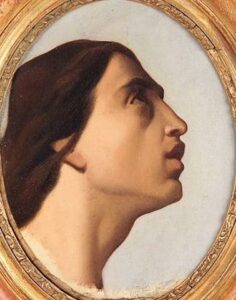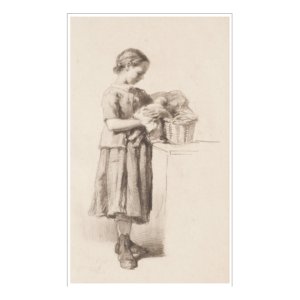Hippolyte Flandrin
Lyon 1809 – Rome 1864
Study of the Head of Saint John the Evangelist in Profile
Oil on paper mounted on canvas
219 x 176 mm – 8 6/8 x 6 7/8 in.
Inscribed in black chalk lower right: 1 Juin 1842 (1st June 1842).
Provenance: Paris, Laurin-Guilloux-Buffetaud sale, March 23rd, 2001, n ° 91; London, Jean Luc Baroni Ltd., 2003; New York, Sotheby’s, January 26th, 2012, n ° 222.
Bibliography: Catalogue Jean-Luc Baroni, 2003, n ° 38.
Born in Lyon, Hippolyte Flandrin began his career frequenting Pierre Révoil’s studio, which encouraged him to complete his training in Paris. A pupil of Jean-Auguste Dominique Ingres, Flandrin received the Prix de Rome in 1832 for Thésée reconnu par son père (Theseus Recognised by his Father, Paris, Beaux-Arts de Paris) and travelled to Villa Medici in Rome. He initially practiced history painting before turning to religious painting and played a leading role in the huge church decoration schemes that took place in the second half of the 19th century, particularly in Paris, Lyon and Nîmes. Flandrin was elected member of the Academy of Fine Arts in 1853.[1]
Our oil study can be compared to the face seen in profile of a young Saint John in the Vocation de saint Jean l’évangéliste (The Vocation of Saint John the Evangelist), one of four murals that Flandrin painted for the chapelle Saint-Jean in the church of Saint-Séverin, Paris between 1839 and 1841.[2]
This commission, received in 1839, constitutes Flandrin’s first monumental work. He made a large number of preparatory cartoons that he used to transfer his designs onto the chapel walls; the squaring up onto a grid is still visible in certain places. The artist illustrates four episodes from the life of Saint John: La Cène, Saint Jean rédigeant l’Apocalypse sur l’île de Patmos, Le martyre du saint plongé dans l’eau bouillante and Sa vocation (The Last Supper, Saint John Writing the Apocalypse on the Isle of Patmos, The Martyrdom of the Saint Immersed in Boiling Water and His Vocation). For this project, Flandrin favoured a technique that combines oil paint and wax, giving a matt finish similar to the antique paintings he admired during his stay in Italy. It is a process that he would use again in Paris, for the churches of Saint-Germain-des-Prés and Saint-Vincent-de-Paul[3].

If the annotation 1 Juin 1842 located at the bottom right of our canvas is by the artist, this would suggest the work was made after the completion of the murals that were inaugurated in 1841. Two other works by Flandrin that illustrate the head of Saint John are also listed: the slightly larger one (240 x 200 mm) is held at the école des Beaux-Arts de Paris [4] (fig. 1), while the oval format work (268 x 218 mm) belongs in the collection of the Ingres Bourdelle Museum in Montauban (fig. 2).[5]

Flandrin frequently used relatives – family, friends and collaborators – as models for the figures of saints in his compositions [6]. Could our head of Saint John be one of the “hidden portraits” in the Saint-Séverin cycle?
Condition report: Oil on paper mounted on canvas.
U.V. lamp examination shows a yellow varnish that prevents a good reading of the work. An old paper crease crosses the composition vertically at the top centre.
[1] For a detailed biography, see: cf. Chronologie_Freres_Flandrin.pdf (mba-lyon.fr)
[2] Hippolyte, Auguste et Paul Flandrin : une fraternité picturale au XIXe siècle (Hippolyte, Auguste and Paul Flandrin: a Pictorial Fraternity in the 19th Century), exhibition catalogue, Paris, Musée du Luxembourg and Lyon, Musée des Beaux-Arts, 1984, p. 82-89. The chapelle Saint-Jean is currently undergoing restoration.
[3] For a more in-depth study of monumental decoration by the Flandrin brothers: Stéphane Paccoud, “L’atelier du décor monumental” (The Monumental Decor Workshop); Hippolyte, Paul, Auguste. Les Flandrin artists et frères (Hippolyte, Paul, Auguste. The Flandrin Artists and Brothers), exhibition catalogue edited by Elena Marchetti and Stéphane Paccoud, Musée des Beaux-Arts de Lyon, 2021, p. 246-270.
[4] Hippolyte, Auguste et Paul Flandrin : une fraternité picturale au XIXe siècle (Hippolyte, Auguste and Paul Flandrin: a Pictorial Fraternity in the 19th Century), exhibition catalogue, Paris, Musée du Luxembourg and Lyon, Musée des Beaux-Arts, 1984, p. 89, n° 28: Oil on canvas, 240 x 200 mm, Signed on the lower right, Hte Flandrin. Inv. MU 71. This work was included in the posthumous sale of Flandrin’s works in 1865, numbered 69: Tête de saint Jean pour le même décoration [Saint-Séverin]./ Année 1840 (Head of Saint John for the same decoration [Saint-Séverin]./ Year 1840).
[5] Inv. MI 974-3-1. Work offered for sale at Hôtel Drouot, Paris, November 23rd, 1973, n° 112. Cf. Idem, p. 89.
[6] Cf. Stéphane Paccoud, op. cit., p. 252-253.






